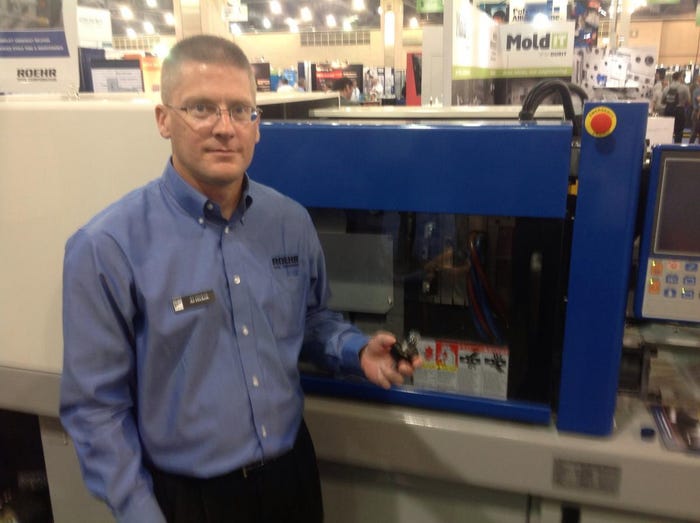Partners Roehr Tool (Hudson, MA) and Westminster Tool (Plainfield, CT) demonstrated a working Dove Tail collapsible core producing threaded caps on a 110-ton electric injection molding machine at the Maruka/Toyo booth at Plastec East, held concurrently recently with Medical Design and Manufacturing East at the Pennsylvania Convention Center in Philadelphia.
July 1, 2013
"It's a great product for medical plastics and other molding because it eliminates the hydraulics used for traditional gear and rack unscrewing systems," said Al Hickok, technical sales manager for Roehr Tool in an interview on the show floor.
|
Al Hickok shows Roehr c-core. |
Introduced in 2009, the DT Core has six segments and has features including variable collapse, split plate actuation and simplified sequencing. In an effort to accelerate adoption of the technology Roehr and Westminster built a demonstration tool that was also shown at Amerimold. A caps and closure specialist, Westminster has been building tools since 1998.
The initial costs to build a mold with DT Core technology can be higher. Return on investment is achieved through reduced cycle time, lower mold cavitation, less mold complexity and a smaller injection molding machine overall.
Cleaner for medical
For medical, the cleanliness is also an increasingly important feature. Hickok said that mold maintenance required for a collapsing core mold is typically half versus unscrewing.
The collapsing approach, introduced by Roehr in 1968, is the least commonly used method to mold threads on caps and closures. Unscrewing is the most common, but it's complicated to build and run. Lubrication is required. Another approach, called jumping threads is a very efficient means of releasing threads but it is limited on diameter and thread depth.
"By not utilizing unscrewing the part can have features such as stop lugs or liner retention shelves to avoid gluing operations," said Hickok. "Also, threads can be placed only where you need them, which eliminate thin steel conditions at the thread run-out."
Mold engineers tend to be very conservative and have been slow to embrace the collapsible core technology, but Hickok said they are gradually becoming more aware of the benefits of the collapsible technology, particularly since the recession forced a new look at total cost economics.
According to Roehr, these are the part cost benefits:
Cycle time reduction is typically 30% or more,
Part weight can be reduced by 5-10%, and
Smaller press is required, which could save $5-10/hr. in machine rate.
Hickok also said that the upfront capital cost for a mold can actually be reduced through use of the c-core system.
Reduce tool cost
"By running faster and more efficiently, a mold with fewer cavities would be needed. For example, a cap requiring 35 million units per year would need a 32- cavity unscrewing mold but only a 16- cavity collapsing core mold based on a conservative 3-4 second reduction in cycle time."
Maintenance times are also cut. A parented quick-lock feature allows removal and servicing of the core while the mold is still in the press.
Roehr Tool Corp. was founded by George Roehr, a mechanical engineer. In the early 1980s, the company developed Minicores for small applications and about a decade later the Expandable Cavities for external forming of threads and undercuts were introduced. Roehr Tool is now part of the Progressive Components International Corp., which also exhibited at Plastec East.
You May Also Like



